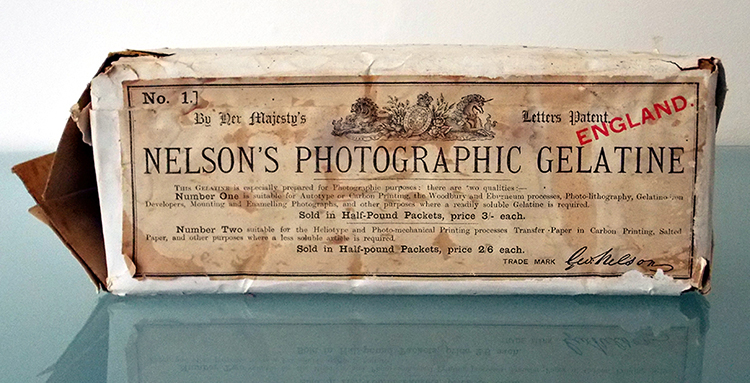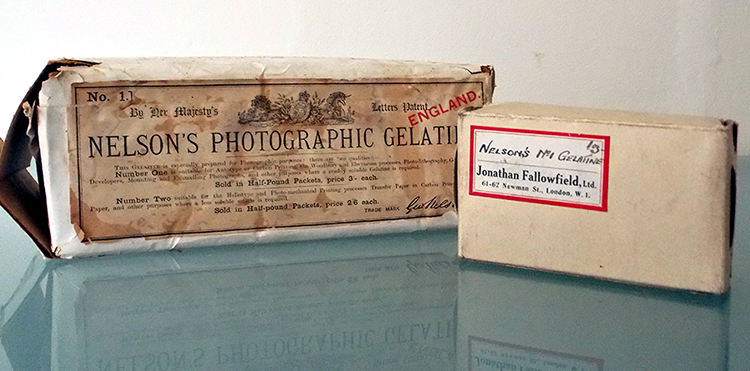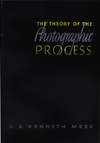
Silver has been a part of photography from the beginning. The photon-activated latent image is the key, of course, but it was gelatin that elevated a phenomenom of physics to pure magic. Without gelatin there is no silver gelatin photography. If a museum or gallery, artist or critic wants to sound particularly fancy, the medium is elevated-by-naming to 'gelatin silver'. Important stuff, gelatin. Important (and fascinating) enough to have its own section. An email from Anthony James Leahy inspired me to start building a separate section just for gelatin. Anthony has followed a trail so many creative people follow — at times serendipitous, at times quixotic. Pure magic.
Anthony's trail led him to research into the history of Nelson's Gelatine, a canonic name in photographic history. Early dry plate recipes refer to it by name. Generic gelatin just wouldn't do!
I leave it to Anthony to introduce himself and his work and his encounter with Edward Montague (Sam) Nelson, followed by three wonderful web pages, and an excellent summary of the history and technology of gelatin for photography by Sam Nelson. Set aside a bit of time to enjoy.
Anthony James Leahy
The majority my working life has been spent as a practitioner of sorts allied to engineering. My leisure preferences have generally been absorbed by my involvement in the creative arts. I have exhibited my photography, locally as well as nationally, and had poetry published in print and electronic form. I have also exhibited some of my paintings in local summer exhibitions, and consider myself a musician of sorts; the guitar being my instrument of pleasure.
During a brief period of unemployment in the 1980’s I worked as a researcher on a project relating to the industrial history of Warwick canals. That was my introduction to research as well as the Nelson Gelatine manufactory at Emscote. Some twenty plus years following that brief encounter I revisited my research after reading a cookery book “Nelson’s Home comforts” which utilised Nelson’s gelatine in its recipes. By this time the internet was well established, so I was encouraged to conduct a little research. My intention was to create a brief history and publish it on a webpage. Some four years on my research has run to nearly one thousand web pages relating to The Nelson’s and gelatine. In 2011 I was invited to conduct a talk at Warwick School by the Warwickshire Industrial and Archaeology Society which attracted a record audience. This was surely boosted by the attendance of Edward Montague Nelson (Sam) who I persuaded to take part in a question and answer session following the talk. My research has slowed of late and I have taken the time to concentrate on my creative side a little more.
I first met Edward Montague Nelson (Sam) at the Nelson Club in Charles Street in February 2010. Sam was aware of my research and website and I was aware that he was living in the area but at the time I wasn’t aware that he still lived in Warwick. I had been researching Geo Nelson, Dale & Co and their gelatine products for couple of years at that stage.
Prior to our meeting Sam had informed that he was essentially the last of the “Nelson dynasty” as he called it, (fifth generation from the founder) founded in 1837 when George Nelson a chemist and entrepreneur began his gelatine business. Sam’s father was honoured with and OBE and the Freedom of Warwick (an honour bestowed on no more than seven others among them Field Marshal Montgomery). Sam’s great grandfather (his namesake) Sir Edward Montague Nelson was knighted by Queen Victoria in her diamond jubilee year.
He commenced his employment at Geo Nelson, Dale & Co in late 1953, spending time in all departments under the guidance of the chief chemist, Dr Richard Coleman. Sam had an involvement in experiments with gelatine for photographic purposes relating to speed control in the 1950’s.
In February 1955 he was employed at the Davis Gelatine South Africa and spent time at the Botany Bay Plant in Sydney Australia (Davis Gelatine were in partnership with Nelson’s at this time).
He returned to Warwick where he continued his career in Gelatine production up until late 1966. Nelson’s gelatine production had ceased by 1970.
A report from the British Journal of Photography, July 23, 1880 (As Printed in Nelson's Home Comforts) Messrs George Nelson, Dale and Co.'s Gelatine Manufactory incorporating advertisements and images relating to Nelson’s photographic gelatine. http://www.mirrormist.com/george_nelson_dale_and_co.htm
Gelatine and its uses plus: Three Gelatine Process Accounts from Nelson, Dale & Co, 1837 George Nelson's Patent - 1899 Alfred Barnard's Peep into the gelatine factory — 1950’s (Sam) Edward Montague Nelson’s recollections. http://www.mirrormist.com/gelatine.uses.htm
A Pictorial History of Nelson’s Gelatine Products from 1837 to 1970. http://www.mirrormist.com/nelsons.lozenges.htm
An excellent summary description of gelatin for photography by Sam Nelson:
The use of gelatine as a medium for coating photographic plates or celluloid film
For gelatine to be a success as a medium, it had to
have a number of properties.
(a) It had to be colourless (or as near as possible)
(b) It had to be formulated so that it produced a flexible emulsion,
particularly, for celluloid film
(c) It had to be free from fat, taking in to consideration that it
was derived from animal skins and/or bones.
(d) In order to facilitate the film makers production process,
it had to have a consistent viscosity; setting strength and setting
rate (at a given concentration).
Now, to understand how this came about, we have to go back to the 17th/18th century country house kitchens where the cooks found that the gravies made from the juices after cooking meat. Sometimes these set to a jelly when cooled as did their ‘stockpots’ after boiling down bones (and everything else they threw in). But it was not consistent; it was cloudy; it had taste and it seemed to lose its ability to ‘gel’ the longer it was kept.
They also learned the technique of using this liquid (provided it ‘gelled’ when cool) to pour previously cooked because they realised that it excluded air (oxygen) from the meat and, therefore, slowed down degradation. (They called it Aspic.)
So the trick for this industrial chemist (George Nelson) in the first part of the 19th century was to find a way of extracting gelatine from skins and bones in a manner that produced a consistent, colourless, tasteless product where a set amount of that product, when added to a set amount of water (a pint) produced a ‘gel’ when cool that was, itself, consistent.
Skins and bones are made up from a series of proteins, the principle one of which is collagen from which gelatine is derived. Many of the others, it was found, could be removed by soaking the skins in an alkaline (lime) solution for several weeks. Nelson's averaged about 10 weeks. Nelson's also went a step further with their alkali treatment by soaking the skins for a further 10 days in a caustic soda solution (highly alkaline).
The skins (bones), by this time, had lost all trace of hair; appeared ‘plumped-up’ and with a very high Ph value (degree of acidity/alkalinity). The next step was to neutralise the high Ph by washing the skins in a mild acid solution (hydrochloric or Sulphuric or Sulphur Dioxide). This would bring back the Ph value to near neutral (Ph7-7.5).
Temperature, time, together with extremes of Ph all had an adverse affect on the gelling capability of extracted gelatine as did the 17th/18th cooks find out when the more they reheated their stockpots the weaker the gelling ability became. And yet, heat was the only way to convert the collagen in to gelatine.
So. A production method was devised by immersing the skins in water and taken to a certain temperature for some hours and the liquid then drained off. This liquid had a concentration of gelatine of 3-5%. This first ‘run’ produced a product with the best colour and the best gelling ability and the least impurities such as fat. The residue was then covered with more water and heated to a higher temperature. The resulting liquid would have more colour and a slightly less gelling ability. This procedure would be repeated up to 5 or 6 times, increasing the temperature on each occasion with the expected results of poorer colour and gelling ability on each run.
The early runs would be kept separate through a filtration process using paper pulp and/or calcined diatomaceous earth followed by the evaporation process which took the concentration to upwards of 20%. The concentrated liquid could then be cooled to set in to a firm jelly and cut in to sheets about ¼” thick.
The drying process was also tricky because, once again, heat had to be applied in order to drive the remaining moisture away, The problem was that heat could, at the same time, melt the jelly. The dried sheets could then be ground to a granulated powder, flaked or left as they were. This depended upon the end-use. In powder form, with the properties now known about each run by tests in the laboratories, it could then be blended to produce a larger ‘batch’ of homogenous product with the gelling properties etc falling within the parameters set by the client.
And so we return to the subject of the use of gelatine as a base for photographic emulsions. I have described how the gelatine manufacturer went about producing a consistent product, however, it was found, I believe, soon after the 2nd World War when home photography came to the fore that if the skins were treated slightly differently during the washing phase the resultant product could have an influence on the light sensitive materials it carried in the film emulsion, making them more or less sensitive to light. I don’t believe that it was the only method used by the film manufacturer to develop ‘fast’ film, but gelatine manufacturers definitely talked about ‘fast’ and ‘slow’ gelatine with their customers. The washing phase that I refer to is about bringing the Ph value back to near neutral with the use of acid solutions. It was a combination of the acids used and the PH value set which had the influence on the film speeds.
Edward Montague Nelson (Sam)

Following up on Anthony's and Sam's excellent contributions, I will be scanning and posting all the best historical information I can find on gelatin. There's a lot, but I'll start where I started reading six years ago — The Theory of the Photographic Process, by Kenneth Meese, Vice President of Research and Development at Eastman Kodak Company for almost half a century. 1945 was the date of the first edition of what would turn out to be one of the most venerable series of photography texts. In subsequent editions the chapter on gelatin was all but eliminated. Thank heavens it was published on paper.
